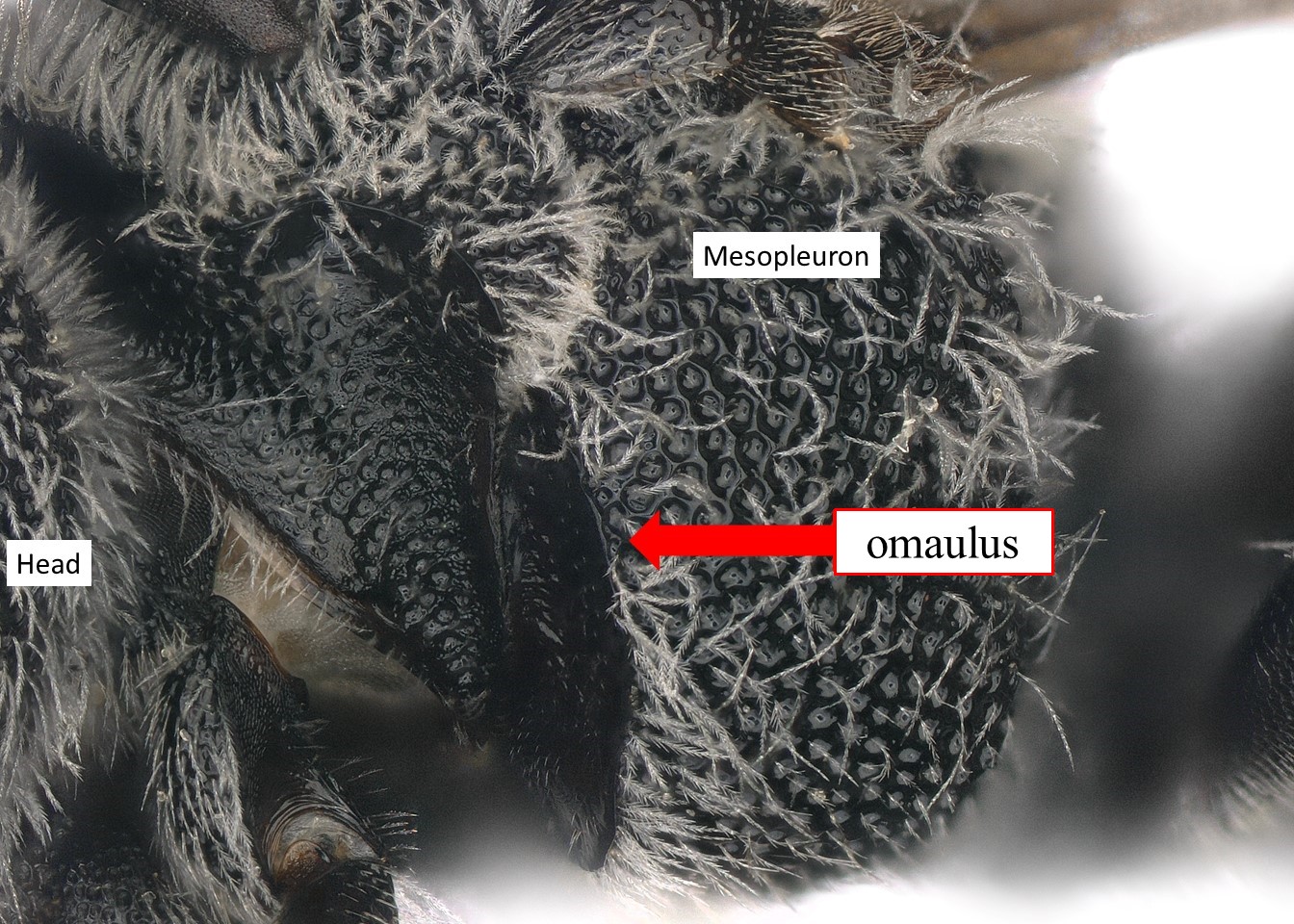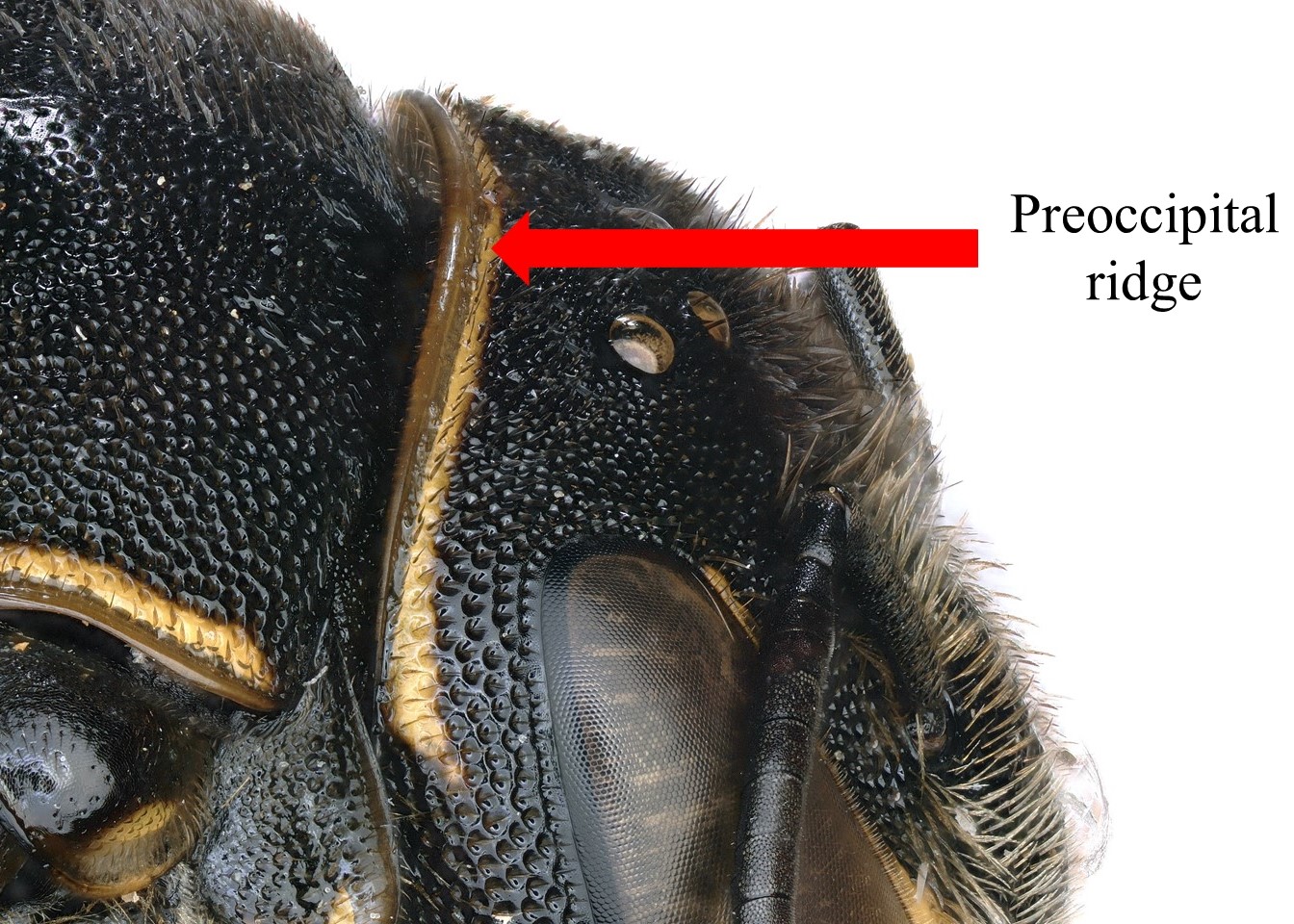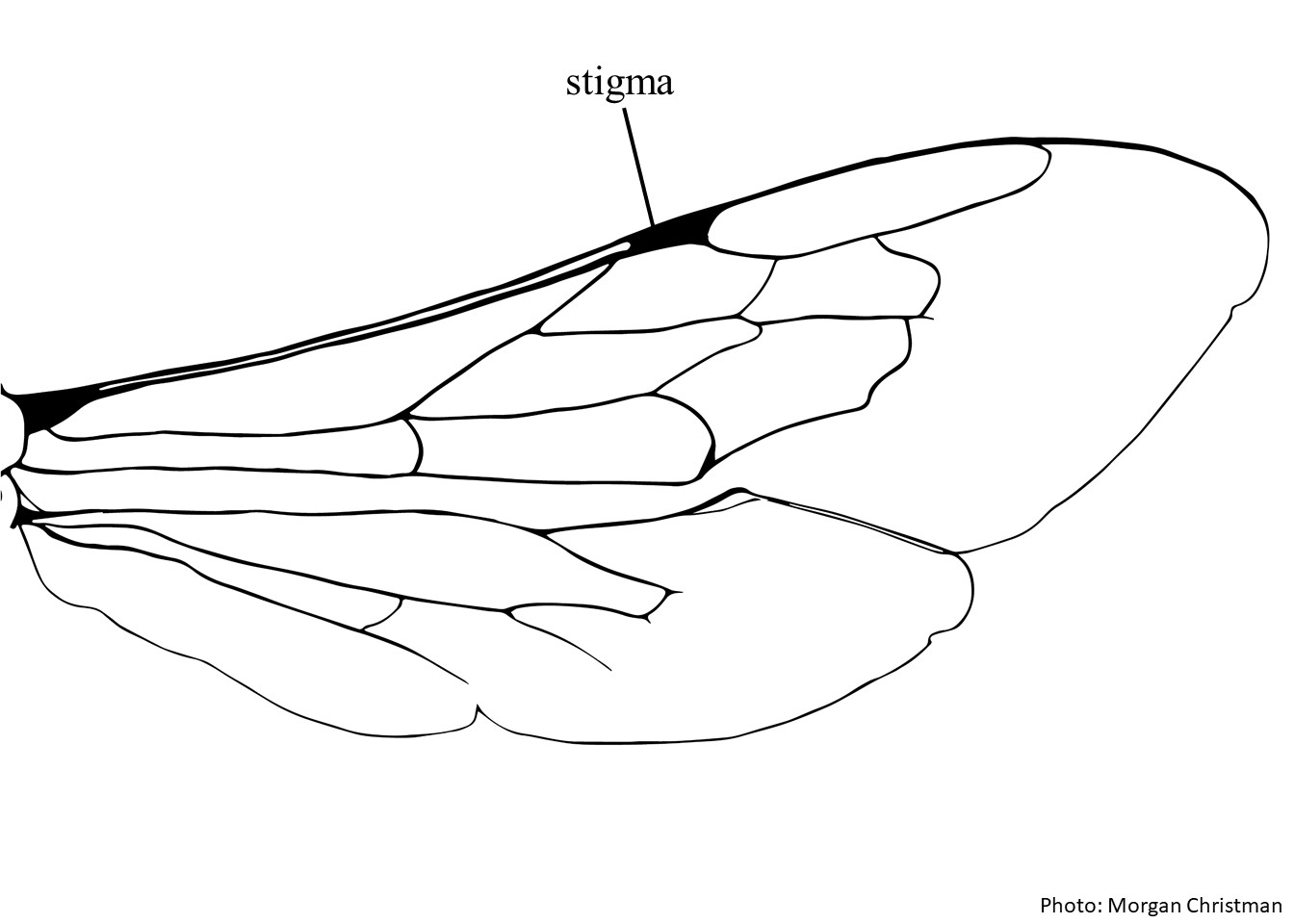Family: Megachilidae
Subfamily: Megachilinae
Tribe: Osmiini
Genus: Protosmia Ducke, 1900
Subgenera: Chelostomopsis, Dolichosmia, Nanosmia, Protosmia
Common name: none
Protosmia are finely punctured, black bees with white hair on the thorax that range in body length from 3.5–9.5 mm. Body form can range from stocky and robust to slender. Protosmia are most often seen flying in the spring (Griswold 1985Griswold 1985:
Griswold, T. 1985. A generic and subgeneric revision of the Heriades genus-group. Logan: Ph.D. thesis, Utah State University. xiii + 165 pp.). The females of the only North American species, P. rubifloris, are easily recognizable by their distinct spatula-like process projecting out from the clypeusclypeus:
a section of the face below the antennae, demarcated by the epistomal sutures (Michener 2007Michener 2007:
Michener, C.D. 2007. The Bees of the World (2nd ed.). Johns Hopkins University Press, Baltimore and London, 953 pp.).
(modified from Michener 2007Michener 2007:
Michener, C.D. 2007. The Bees of the World (2nd ed.). Johns Hopkins University Press, Baltimore and London, 953 pp. unless otherwise stated)
 without carinacarina:
without carinacarina: without carinacarina:
without carinacarina: at least twice as long as broad. T1T1:
at least twice as long as broad. T1T1: lacks carinacarina:
lacks carinacarina: with a brush of hair under the margin (Griswold 1985Griswold 1985:
with a brush of hair under the margin (Griswold 1985Griswold 1985: and S3S3:
and S3S3: with posterior margins notched or stepped laterally (only in species from Eastern Hemisphere).
with posterior margins notched or stepped laterally (only in species from Eastern Hemisphere). lacks preapicalpreapical:
lacks preapicalpreapical: with distinct preapicalpreapical:
with distinct preapicalpreapical: margin (Michener 2007Michener 2007:
margin (Michener 2007Michener 2007: of the male, and the distribution of Othinosmia is restricted to sub-Saharan Africa.
of the male, and the distribution of Othinosmia is restricted to sub-Saharan Africa.
There are no known invasives.
There are few published floral records associated with Protosmia species. Some Protosmia appear to prefer flowers in Lamiaceae and Fabaceae (Popov 1961Popov 1961:
Popov, V.V. 1961. On the evolution of the bee genera Protosmia Ducke and Chelostomopsis Cockerell. Zoologicheskii Zhurnal 40: 359ndash;371.). Protosmia rubifloris is considered a generalist but might specialize on Salvia based on pollen samples collected by Griswold (1986).
Protosmia are solitary and known to nest in preexisting natural cavities. Protosmia rubifloris is presumed to nest in preexisting cavities in wood and has been found nesting in pinecones (Griswold 1986Griswold 1986:
Griswold, T. 1986. Notes on the nesting biology of Protosmia ( Chelostomopsis ) rubifloris (Cockerell) (Hymenoptera: Megachilidae). The Pan-Pacific Entomologist 62: 84ndash;87.). They do not line the cells, but rather form cell partitions of resin sometimes integrating an empty interstitial cell between brood cells. Nests are plugged after construction with resin with the occasional addition of small gravel bits (Griswold 1986Griswold 1986:
Griswold, T. 1986. Notes on the nesting biology of Protosmia ( Chelostomopsis ) rubifloris (Cockerell) (Hymenoptera: Megachilidae). The Pan-Pacific Entomologist 62: 84ndash;87.). Adults have been found overwintering within brood cells, a behavior that is not common in megachilids. Other Protosmia have been found to nest in hollow stems and members of the subgenus Protosmia utilize a variety of preexisting cavities, such as rock crevasses and abandoned mud wasp nests (summary by Griswold 1985Griswold 1985:
Griswold, T. 1985. A generic and subgeneric revision of the Heriades genus-group. Logan: Ph.D. thesis, Utah State University. xiii + 165 pp.). Multiple species have been noted to nest inside empty snail shells (Popov 1961Popov 1961:
Popov, V.V. 1961. On the evolution of the bee genera Protosmia Ducke and Chelostomopsis Cockerell. Zoologicheskii Zhurnal 40: 359ndash;371.).
Protosmia has a disjunct distribution with most species occurring in the Mediterranean, North Africa, Europe, southwestern Asia, and northern India (Michener 2007Michener 2007:
Michener, C.D. 2007. The Bees of the World (2nd ed.). Johns Hopkins University Press, Baltimore and London, 953 pp.). However, P. (Chelostomopsis) rubifloris occurs in coastal, montane, and mid-elevational desert habitats of western North America, British Colombia, Canada, and Baja California, Mexico (Michener 2007Michener 2007:
Michener, C.D. 2007. The Bees of the World (2nd ed.). Johns Hopkins University Press, Baltimore and London, 953 pp.). Other species of the Chelostomopsis subgenus are known in the Mediterranean region from Morocco to Turkey and Lebanon (Michener 2007Michener 2007:
Michener, C.D. 2007. The Bees of the World (2nd ed.). Johns Hopkins University Press, Baltimore and London, 953 pp.). The only member of the Dolichosmia subgenus, P. burmanica, is a rare bee of Myanmar (Michener 2007Michener 2007:
Michener, C.D. 2007. The Bees of the World (2nd ed.). Johns Hopkins University Press, Baltimore and London, 953 pp.). The most widespread subgenus, Nanosmia, occurs throughout the Mediterranean region in Europe (Spain, Portugal, France, Greece), Africa (Morocco to Tunisia), the Middle East (Israel, Syria, Saudi Arabia, United Arab Emirates), Turkey, and Central Asia (Tajikistan, Pakistan, and Kashmir region of India). The Protosmia subgenus also inhabits the Mediterranean region, from Spain to Israel eastward to Turkey and Transcaucasia (Michener 2007Michener 2007:
Michener, C.D. 2007. The Bees of the World (2nd ed.). Johns Hopkins University Press, Baltimore and London, 953 pp.).
Distribution map generated by Discover Life -- click on map for details, credits, and terms of use.
Griswold, T. 1985. A generic and subgeneric revision of the Heriades genus-group. Logan: Ph.D. thesis, Utah State University. xiii + 165 pp.
Griswold, T. 1986. Notes on the nesting biology of Protosmia (Chelostomopsis) rubifloris (Cockerell) (Hymenoptera: Megachilidae). The Pan-Pacific Entomologist 62:84-87.
Michener, C.D. 2007. The Bees of the World (2nd ed.). Johns Hopkins University Press, Baltimore and London, 953 pp.
Popov, V.V. 1961. On the evolution of the bee genera Protosmia Ducke and Chelostomopsis Cockerell. Zoologicheskii Zhurnal 40: 359-371.